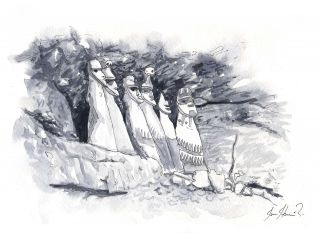

Who is the Cloud People?
Chachapoyas Culture
The nickname given to this people comes from the region where the Chachapoyas had installed their domination zone: half-way between jungle and mountain, the meeting between hot and humid air, from Amazonia, and the cool and dry air from the Andes, provoked at this height very important cloudy condensation bands.
Nowadays, the Chachapoyas still a mystery that excite the spirit of many explorers and “huaqueros” (grave scavengers). On the basis of circular tombs and other tombs attached to cliffs we could discover now, there is a quick presentation of what would have been the great civilization who built Kuelap (the most important pre-Inca construction in Peru, after Machu Picchu).
This war-like people was particularly ferocious. It seems that they exposed their enemies’ head on pics to show their courage and to discourage other peoples to come and disturb. The Inca themselves, during their incredible territorial expansion, have faced big difficulties when they wanted to submit the Chachapoyas people. Furthermore, punctual rebellions were organized during the Inca administrative on their lands, sign of an eternal submission spirit.
They also were very good builders, who knew very well how to accommodate and be at one with nature surrounding to obtain maximum benefits, both at the esthetic and the practice level. The circular ruins they gave to us still in an excellent state, taking account of the erosion level with wind and rains that wiped out the region. Kuelap is, obviously, the greatest and the most beautiful example: with its front wall of 6 to 12 meters high, its major fortress of 700 meters long, edifices with various floors, temples and habitations still intact… The isolation techniques from the rain were, for example, very developed; thatched roofs allowed a waterproofing equal to none for the accommodations.
Their artistic sense was, also, very developed: the decoration of architectural works are amazing. Geometric shapes like lozenges, broken lines, friezes on walls or representation of sacred animals like snake, puma or condor.
We have to know that much remains to be discovered to understand better the way of life, the social organization and the world view of this great people. One thing is certain, the natural environment, made of big bands of clouds, raining on the half-tropical vegetation, as well as the archaeological rests of this pre-Hispanic people, will continue exciting during many years the visitors imagination who are in search of dream.



